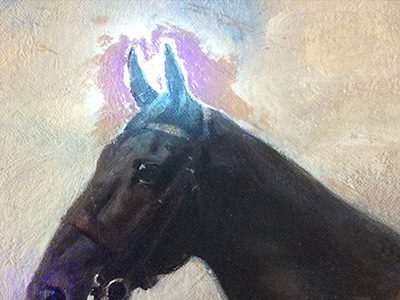UV is often the enemy in conservation. But it can also be a force for good! So how can conservators use ultra-violet light?
Chances are that you spend far more time working out how to block damaging UV light, than how to use it. It’s understandable – UV light can cause a number of problems when objects are subject to excessive exposure. But you can use it in a few conservation practices where its special talent for revealing the ‘invisible’ could save time, for example condition surveys.

> | View all UV products click here
UV light is invisible to the naked eye and is the definition of wavelengths in the electro-magnetic spectrum between 10nm and 400nm.  Although invisible to the human eye, some materials can absorb and re-emit energy from UV radiation in a lower wavelength as visible light, this is called photoluminescence.
Although invisible to the human eye, some materials can absorb and re-emit energy from UV radiation in a lower wavelength as visible light, this is called photoluminescence.
The behaviour can be different depending upon the material re-emitting the energy. This is where examining with UV light can be especially useful in conservation.
> | View all UV products click here
So what can you do with UV?
When examining with UV light; imperfections, repairs, damage, mould, faded inks, which were difficult to see, can become quite obvious. UV light and the luminescence, or absence of, can also provide clues as to the material/s an object is constituted, or not as the case may be. With prior knowledge of the behaviour of various objects and materials when exposed to UV light, identification and dating can be made easier. As an example, some genuine glassware will fluoresce and the colour can therefore be helpful in identification, the reproductions do not fluoresce (just an example, but you get the idea).
An excellent guide to some of the observed luminescence on conservation materials is available here (The Australian Institute for the Conservation of Cultural Material).
As an example of how UV light can be used, the image (below) shows a painting that has been restored. The over-painting is clearly visible under the UV light as the two materials, new and old, react very differently when exposed.

Another example of an application that may be useful in a conservation setting is using UV light to reveal faded inks in old manuscripts which may have become illegible.
Multi-spectral imaging uses UV to do the same job. UV can be used in part to identify iron gall ink.
What light's the right light?
Of course, just using the catch-all title ‘UV light’ doesn’t really tell the full story. UV light, as mentioned earlier, represents the electro-magnetic spectrum between 10nm and 400nm. UV lights and torches usually cover a very narrow range of light, with a specific working peak output. It’s generally recognised within conservation that the vast majority of applications for UV light fall in or around the 365nm wavelength. As a result, most of our UV torches and lights are available with a peak output of 365nm (although we also stock others).
So, what’s a Wood’s Lamp?
A
'Woods lamp' is a UV lamp, like a ‘Hoover’ is a vacuum cleaner. The name comes from American physicist Robert Williams Wood who invented a treatment for glass which only allowed UV and infra-red light to pass through. The method for manufacturing UV lamps has changed since his 1903 invention but the name has remained.
UV is also commonly used in museums and galleries outside of the conservation studio or laboratory to reveal security markings (such as those written with one of these UV security pens) on valuable assets, or those on bank notes. Those of you with manicured nails may well have used a UV lamp to cure them, this is also a viable method for some adhesives and inks.
Safety should never be ignored when using UV lighting. Appropriate protective eyewear, gloves and clothing should be worn and prolonged exposure avoided.
If you’re more interested in controlling UV light levels read our
blog post here.
> | View all UV products click here